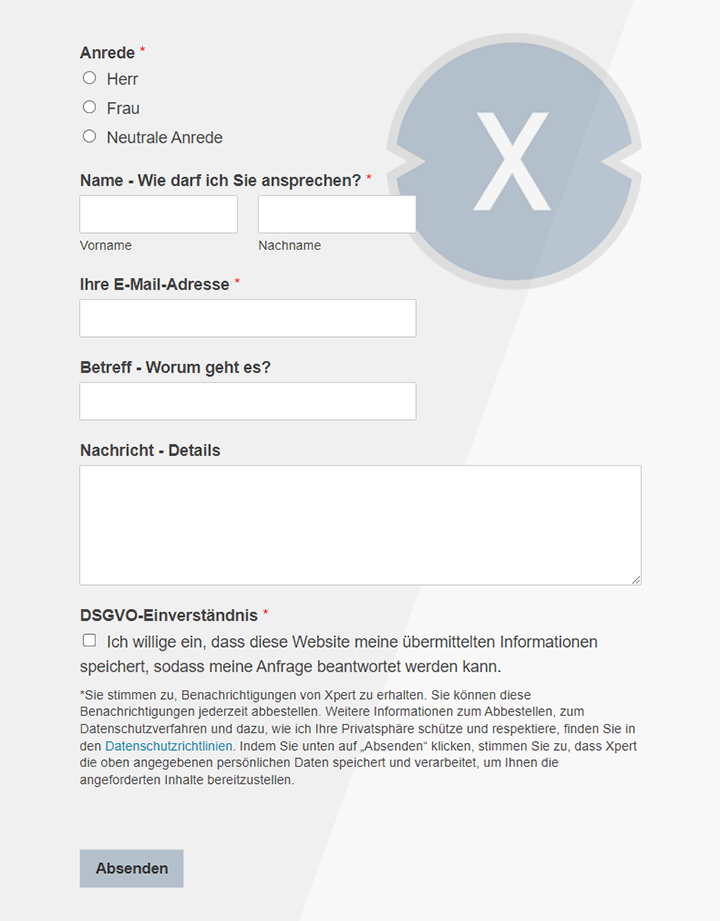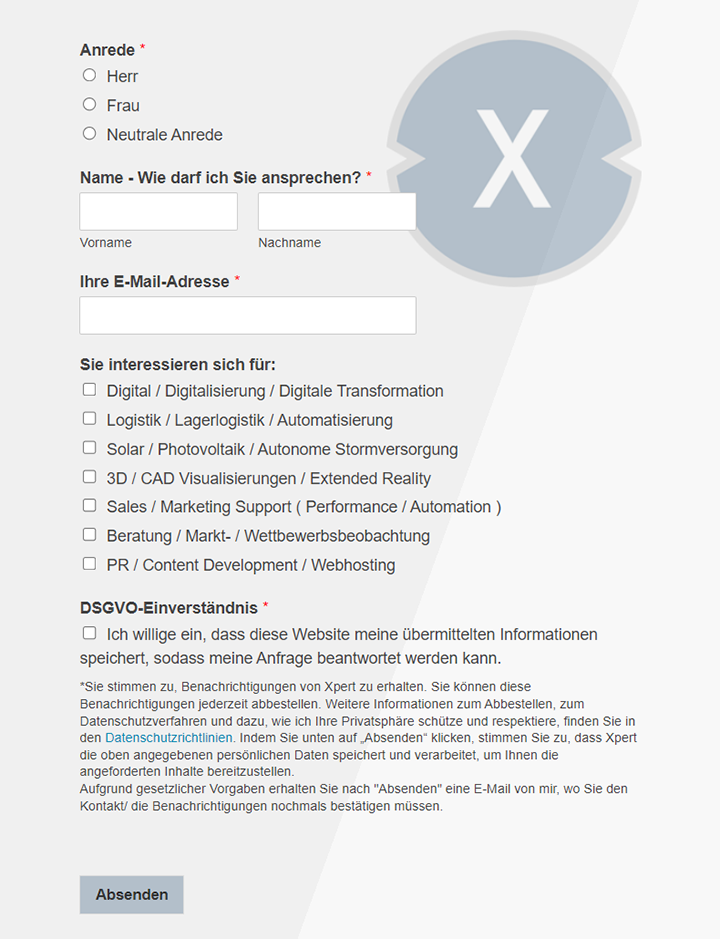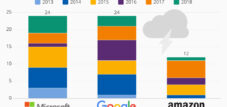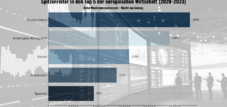US policy inspires EU tech companies? Data sovereignty of US dominance: The future of the cloud in Europe
Xpert pre-release
Language selection 📢
Published on: April 13, 2025 / update from: April 13, 2025 - Author: Konrad Wolfenstein

US policy inspires EU tech companies? Data sovereignty of US dominance: The future of the cloud in Europe-Image: Xpert.digital
Cloud decisions in companies: What really counts-price, innovation or data security?
The European cloud market: between US policy, EU regulation and the pursuit of digital sovereignty
The digital transformation has accelerated rapidly in recent years and the cloud has become the central nervous system of modern companies and organizations. The European cloud market is a particularly exciting and dynamic field that is shaped by a variety of factors. In addition to the general trend towards cloud use, political and regulatory influences also play an important role here.
A frequently expressed thesis is that US policy, especially during the term of office of President Donald Trump, triggered an “upswing” for European technology companies, especially in the cloud and software area. This thesis is based on the assumption that the United States outgoing uncertainty and the protectionist trade policy would have caused European companies to rely on local providers.
This article examines the validity of this thesis and analyzes the complex relationships between US politics, EU regulation, market dynamics and the pursuit of digital sovereignty in the European cloud market. It becomes clear that reality is far more complex than the simple equation “US policy equal upswing for European providers”.
Suitable for:
- Trusty AI: Europe's trump card and the chance of taking on a leading role in artificial intelligence
The European cloud market at an overview: growth, competition and digital sovereignty
The European cloud market is a market with enormous growth potential. Forecasts assume that the Public Cloud Services (PCS) market will reach a volume of $ 415 billion by 2028 in the Europe, the Middle East and Africa (EMEA) region. This corresponds to an average annual growth rate (CAGR) of 20.0 % in the period from 2023 to 2028. In Europe alone, the market was estimated at over $ 80 billion in 2024, with an expected CAGR of 17.1 % until 2034.
This growth is primarily driven by the following factors:
The need for companies to become more agile and flexible
Cloud technologies enable companies to react quickly to changed market conditions and to develop new business models.
The desire for cost efficiency
Cloud solutions can help companies reduce their IT costs by using resources as required and do not have to buy and wait expensive hardware.
The need for innovation
Cloud platforms offer access to a variety of innovative technologies, such as artificial intelligence (AI), Machine Learning (ML) and Big Data Analytics that can help companies develop new products and services.
The increasing demand for artificial intelligence (AI)
In particular, generative KI (Genai), which, according to experts, makes up half of market growth.
Despite the dynamic growth, the European cloud market is dominated by a handful of American hyperscals. Amazon Web Services (AWS), Microsoft Azure and Google Cloud together hold a market share of over 70 % in Europe. This dominance creates an inherent tension between the use of global cloud innovations and the protection of European values, especially with regard to data protection and regulatory control.
Against this background, the concept of “digital sovereignty” has become increasingly important in Europe. Digital sovereignty means that a state or organization has control over its own digital infrastructures and data and can shape them in accordance with its own rules and values. The striving for digital sovereignty is closely associated with the desire to reduce the dependence on non -European providers and to keep control of your own data.
Transatlantic politics: US measures and European reactions
In order to better understand the complex relationships in the European cloud market, it is important to analyze the political and regulatory influences from the USA and the EU.
US trade policy and their effects on the technology sector
US trade policy has had a strong impact on the technology sector in recent years, in particular through protectionist measures and geopolitical tensions. Here are the most important developments and their effects:
Protectionist trading policy under Trump
- Customs on imports: President Trump has increased tariffs on steel, aluminum, cars and auto parts as well as technologies such as semiconductor and electronics products in his current term. However, these measures aim to protect domestic industry, but have disturbed global supply chains and increased the production costs for US technology companies such as Apple and Amazon.
- Width effects on the technology sector: The new tariffs, which also affect important trading partners such as the EU, China, South Korea and India, have led to higher prices for electronic products. Experts estimate that these tariffs could reduce the purchasing power of US consumers for technology products by up to $ 143 billion.
Export controls and technology restrictions
- AI chips and national security: The United States has introduced stricter export controls for AI chips under the bid government in order to restrict the access of China and other countries to critical technologies. This policy was further tightened by the Trump government. The aim is to secure the technological management position of the United States.
- Global effects: These measures have not only taken China, but also countries in the Middle East and Southeast Asia, which are increasingly investing in data centers. This has led to geopolitical tensions because countries like the United Arab Emirates were forced to give up partnerships with Chinese companies.
Trade conflicts with the EU
- EU countermeasures: The EU has reacted to US tariffs with its own retaliation measures worth 26 billion euros. In addition, instruments such as the Anti-Coercion Instrument (ACI) could be used to make it difficult to access the European procurement market.
- Digital regulation: The EU has introduced strict digital regulations (e.g. Digital Markets Act) that US technology companies incorporate billions of annual compliance costs. These regulations aim to prevent market abuse through large platforms such as Google or Meta.
While the EU originally announced such measures, they were initially exposed to the recent developments in the trade dispute between the USA and the EU.
On April 10, 2025, the EU Commission decided to suspend the planned counter tariffs for a period of 90 days in order to give negotiations with the USA. This decision was made in response to a similar announcement by US President Donald Trump, who also granted a 90-day break for new tariffs. The EU emphasized its willingness to find a negotiating solution in order to avoid an escalation of the trade conflict.
The planned counter -tariffs, which were originally supposed to come into force from April 15, 2025, are therefore put on ice for the time being. These measures would have been a response to the tariffs imposed by the USA on steel, aluminum and other products and would have included customs sets between 10 % and 25 %.
In summary: the EU has prepared countermeasures, but temporarily suspended them due to the current negotiation situation.
Effects on global IT editions
- Slowing growth: The new tariffs have the potential to slow the growth of global IT expenses. IDC estimates that the growth from originally forecast could fall 10 % to 5 %.
- Inflationary effects: The higher costs for hardware and infrastructure also have an indirect effect on software and cloud services, since providers are forced to pass on price increases.
Current US trade policy has significantly influenced the technology sector. While she is aiming to protect national interests and secure geopolitical advantages, it at the same time leads to higher costs, disturbed supply chains and an tightening of global trade conflicts. Companies with global production and sales networks as well as consumers are particularly affected by increasing prices for technology products.
The Cloud Act: A law with far -reaching consequences
Another central element of US policy with direct effects on the cloud sector is the cloud act (Clarifying Lawful Overseas Use of Data Act). This law authorizes US authorities to request the publication of data by US-based technology companies and their subsidiaries, regardless of where this data is physically stored-also on servers in Europe.
The cloud act is in direct conflict with the principles of the European General Data Protection Regulation (GDPR), in particular with regard to the strict rules for international data transfers and the limitation of state access. US companies are legally obliged to meet inquiries about the cloud act, even if this violates European law.
The cloud act is probably the US policy measure with the most extensive consequences for the European cloud market. It creates a fundamental legal conflict with the GDPR and undermines the confidence in the ability of US providers to meet European data protection standards, even if the data is stored in European data centers. This directly fuels the demand for “confident” European cloud alternatives that promise to subject only European law to data.
Suitable for:
- Europe's way to technological sovereignty through AI-based automation: An analysis of the Kiro 2024 recommendations
The EU regulatory framework: data protection, sovereignty and competition
The European Union has issued a number of laws and initiatives in recent years to shape digital space in Europe and to strengthen digital sovereignty.
The GDPR
The GDPR that came into force in 2018 established a strict and comprehensive legal framework for the protection of personal data in the EU. Their core principles include transparency, purpose binding, data minimization, guaranteeing rights and strict rules for the transmission of data into third countries. The GDPR put the bar for data protection very high and created the basis for later conflicts with laws such as the cloud act.
The Schrems-II judgment
This judgment of the European Court of Justice (ECJ) declared the EU-US privacy Shield agreement invalid. The reason was that US law does not offer sufficient protection for the data of EU citizens before government access. The Schrems II judgment was a turning point with direct consequences for US cloud providers. The invalidity of the Privacy Shields removed an important legal basis for transatlantic data transfers and significantly increased compliance load and legal uncertainty for thousands of companies.
The EU digital strategy
The EU has issued a number of other laws to design its digital space. The Digital Markets Act (DMA) and the Digital Services Act (DSA) aim to limit the market power of large online platforms, to promote fair competition and to regulate online content and services. The Data Act and Data Governance Act should facilitate and promote data exchange and access to data. The AI Act determines rules for the use of artificial intelligence. These regulations shape the digital market in Europe together with the aim of strengthening fairness, competition, innovation and user security.
The Gaia-X Initiative
GAIA-X was launched as a European initiative to create a federated, safe and interoperable data infrastructure based on European values such as transparency, data protection and sovereignty. The goal is not to become a cloud provider yourself, but to set standards and enable an ecosystem that reduce the dependency on non-European providers.
🎯📊 Integration of an independent and cross-data source-wide AI platform 🤖🌐 for all company matters

Integration of an independent and cross-data source-wide AI platform for all company matters-Image: Xpert.digital
Ki-Gamechanger: The most flexible AI platform-tailor-made solutions that reduce costs, improve their decisions and increase efficiency
Independent AI platform: Integrates all relevant company data sources
- This AI platform interacts with all specific data sources
- From SAP, Microsoft, Jira, Confluence, Salesforce, Zoom, Dropbox and many other data management systems
- Fast AI integration: tailor-made AI solutions for companies in hours or days instead of months
- Flexible infrastructure: cloud-based or hosting in your own data center (Germany, Europe, free choice of location)
- Highest data security: Use in law firms is the safe evidence
- Use across a wide variety of company data sources
- Choice of your own or various AI models (DE, EU, USA, CN)
Challenges that our AI platform solves
- A lack of accuracy of conventional AI solutions
- Data protection and secure management of sensitive data
- High costs and complexity of individual AI development
- Lack of qualified AI
- Integration of AI into existing IT systems
More about it here:
EU vs. USA: Who determines the rules of the game in digital space?
The relative effects: a comparative analysis
When evaluating the effects of US politics and EU regulation on the European cloud market, it is important to distinguish between direct and indirect effects. EU regulations such as the GDPR and the Schrems II judgment as well as the US Cloud Act had direct legal consequences for data processing and the choice of cloud providers. They created immediate compliance requirements and legal risks. The US trade policy in the narrower sense worked indirectly to the cloud market by stinging into uncertainty and problematized the strategic dependence on the USA.
The EU regulations and initiatives can be interpreted as proactive attempts to design digital space according to European ideas and values. In contrast, market shifts in favor of European providers could sometimes be seen as reactive answers to the problems caused by US policy (especially cloud act) and legal uncertainty (Schrems II).
The combined effect, the direct applicability and the long-term character of the EU regulations as well as the strategic initiatives appear more fundamental drivers for the design of the rules and structure of the European cloud market compared to the more episodic and often indirect effects of US trade policy.
The development of the European cloud market: growth, competition and market shares
The European cloud market has experienced strong growth in recent years. This growth is driven by the progressive digital transformation, the increasing use of platforms and software-as-a-a-service (SaaS), the need for scalability and flexibility as well as cost efficiency.
Within the market, SaaS is still the largest segment, Platform-as-A-Service (PAAS) is the fastest growing segment, followed by infrastructure-a-service (IAAS). The use of cloud computing is widespread in European companies. The trend is clearly more intensive use and many companies pursue multi-cloud or hybrid cloud strategies to maximize flexibility and avoid provider dependency.
Despite the strong growth, the European cloud market is clearly dominated by the three major US hyperscalers: AWS, Microsoft Azure and Google Cloud. Your combined market share in Europe is over 70 %. Although European cloud providers have more than doubled their sales since 2017, their collective market share has dropped significantly in the same period.
The leading European providers include Deutsche Telekom/T-Systems, SAP, OVHCloud, Orange and Telecom Italia as well as a number of other national and regional actors. The fundamental reason for the falling market share of European providers despite increasing sales lies in the massive scale and investment advantage of the US hyperscaler. Their global operations, enormous research and development budgets and the continuous expansion of their infrastructure create a competitive situation that is extremely challenging for European competitors.
Suitable for:
- Europe's AI ambitions in global competition: a comprehensive analysis-digital colony or does the breakthrough come?
Performance analysis of selected European providers
SAP
SAP has carried out a successful transformation towards a cloud company, which is shown in strong growth in sales in this segment. SAPs Cloud growth is strongly based on the migration of its large existing corporate customer base on cloud solutions.
Ovhcloud
As a European “Pure Play” cloud provider, Ovhcloud reports solid growth and profitability. The growth is based on both segments (private and public cloud), whereby the company often advertises with a good price-performance ratio and should benefit from the demand for sovereign solutions.
Deutsche Telekom / T-Systems
As part of the Telekom group, T-Systems has a significant size in a European comparison (except SAP). The growth appears solid, but more moderate than the overall market. The strategy clearly aims to be a leading European alternative through partnerships, industry focus and sovereign offers, especially for regulated sectors and the public sector.
Nextcloud
NextCloud positions itself as an open source alternative for on-premises or private cloud collaboration with strong focus on digital sovereignty. NextCloud benefits directly from sovereign concerns and the problems related to GDPR and Cloud Act. Your own growth history is explicitly linked to these factors and presented as a counter-position to US hyperscalers.
Customer decisions: sovereignty, scalability, innovation and costs
The decision for a cloud provider is rarely only driven by sovereign aspects. Customers must weigh them against other critical factors:
Scalability and performance
US hyperscales offer an unsurpassed global range, massive infrastructure capacities and often high performance.
Functional range and innovation
Hyperscalers are often leading in the width and depth of their services, especially in advanced technologies such as AI and machine learning.
Cost
Public clouds offer the potential for cost savings and flexible pricing models.
Existing ecosystems/knowledge
Many organizations have already invested in Hyperscaler platforms, have appropriately trained staff and use partner networks, which makes it difficult and more expensive to change.
Despite the sovereign concerns, many European customers continue to choose AWS, Azure or Google Cloud - especially outside of heavily regulated industries - because they prioritize their scalability, innovative strength, variety of functions and established ecosystems.
The demand for digital sovereignty is not equally pronounced in the entire market. Their importance varies significantly depending on the industry - the public sector, the healthcare system and the financial sector are typically more sensitive than other areas - and also depends on the specific sensitivity of the data and workloads.
Analysts emphasize the need to weigh up sovereignty against functions, costs and complexity. European providers often aim at regulated industries or public clients in which sovereignty has top priority. The development of “sovereign” offers from US hyperscalers is recognition of this segmented demand-they try to meet specific compliance requirements in order not to lose customers fully.
Suitable for:
- The digital dependence on the USA: cloud dominance, distorted trading balance sheets and lock-in effects
Evaluation of the "upswing"-US policy influence vs. broader trends
The analysis shows that direct tariffs on cloud services were not an essential factor. The disputes around digital taxes produced tensions, but did not fundamentally block the US providers.
The general trade conflicts, political unpredictability and the "America First" rhetoric during the Trump administration probably contributed to the fact that some European customers put their dependencies and questioned the reliability of the USA as a partner. This climate of uncertainty could have increased the attractiveness of European alternatives.
The US Cloud Act had significant and direct negative effects on the perceived trustworthiness and compliance of US providers in dealing with sensitive data, especially in interaction with the GDPR and through the Schrems II judgment. This created clear market opportunities for European alternatives that emphasize data sovereignty.
However, it must be emphasized that the EU itself has significantly designed the rules of the digital market in Europe through its legislation (GDPR, Schrems II) and its strategic agenda (DMA, DSA, Data Act, GAIA-X), sharpened the awareness of data protection and sovereignty and actively promoted the demand for compliant solutions. These European framework conditions were more fundamental for market development as external political influences.
The growth of European providers took place in a market environment that massively expanded through the digital transformation. Part of sales growth is therefore due to the general market growth, from which all providers benefited. The overarching trend towards relocating IT workloads to the cloud to increase efficiency, scalability and innovative ability (especially by KI/ML) was the main engine of market growth.
The assertion that US trade policy was the main cause of an “upswing” European technology company is largely not durable or at least a significant simplification. US data protection-related politics (cloud act) and the uncertainty funded during the Trump era contributed significantly to the tightening of sovereignty concerns and gained certain EU providers who used this demand. However, this effect was closely interwoven with and probably secondary to the effects of EU regulations and the general market expansion through digital transformation.
There was no general "upswing" that would have shifted the market dominance. Rather, specific European providers found fertile soil for growth by responding to sovereign concerns that were reinforced by US measures and EU regulations. At the same time, the overall market continued its rapid expansion, led by the US hyperscalers who benefited from scale effects and innovation leadership.
Strategic outlook and recommendations
For EU technology providers
The focus should be on differentiation by guaranteed sovereignty, the targeted address of regulated industries and the public sector, the structure of strong partner ecosystems, innovations in niche areas and potentially cooperation in federated solutions.
For EU politicians
The promotion of the digital internal market should continue, as well as the support of initiatives such as Gaia-X. It is important to clarify regulations, the promotion of interoperability standards and investments in digital skills and infrastructures.
For cloud customers in companies
It is advisable to develop clear multi-cloud or hybrid strategies based on the sensitivity of workloads, compliance requirements and business goals. Promising the sovereignty of the providers should be carefully checked.
Future trends
The effects of AI on the cloud competition, the further development of sovereign cloud offers by all actors, the practical implementation and acceptance of GAIA-X as well as the continuing stability of transatlantic data transfer agreements can be observed.
We are there for you - advice - planning - implementation - project management
☑️ SME support in strategy, consulting, planning and implementation
☑️ Creation or realignment of the AI strategy
☑️ Pioneer Business Development
I would be happy to serve as your personal advisor.
You can contact me by filling out the contact form below or simply call me on +49 89 89 674 804 (Munich) .
I'm looking forward to our joint project.
Xpert.Digital - Konrad Wolfenstein
Xpert.Digital is a hub for industry with a focus on digitalization, mechanical engineering, logistics/intralogistics and photovoltaics.
With our 360° business development solution, we support well-known companies from new business to after sales.
Market intelligence, smarketing, marketing automation, content development, PR, mail campaigns, personalized social media and lead nurturing are part of our digital tools.
You can find out more at: www.xpert.digital - www.xpert.solar - www.xpert.plus





























